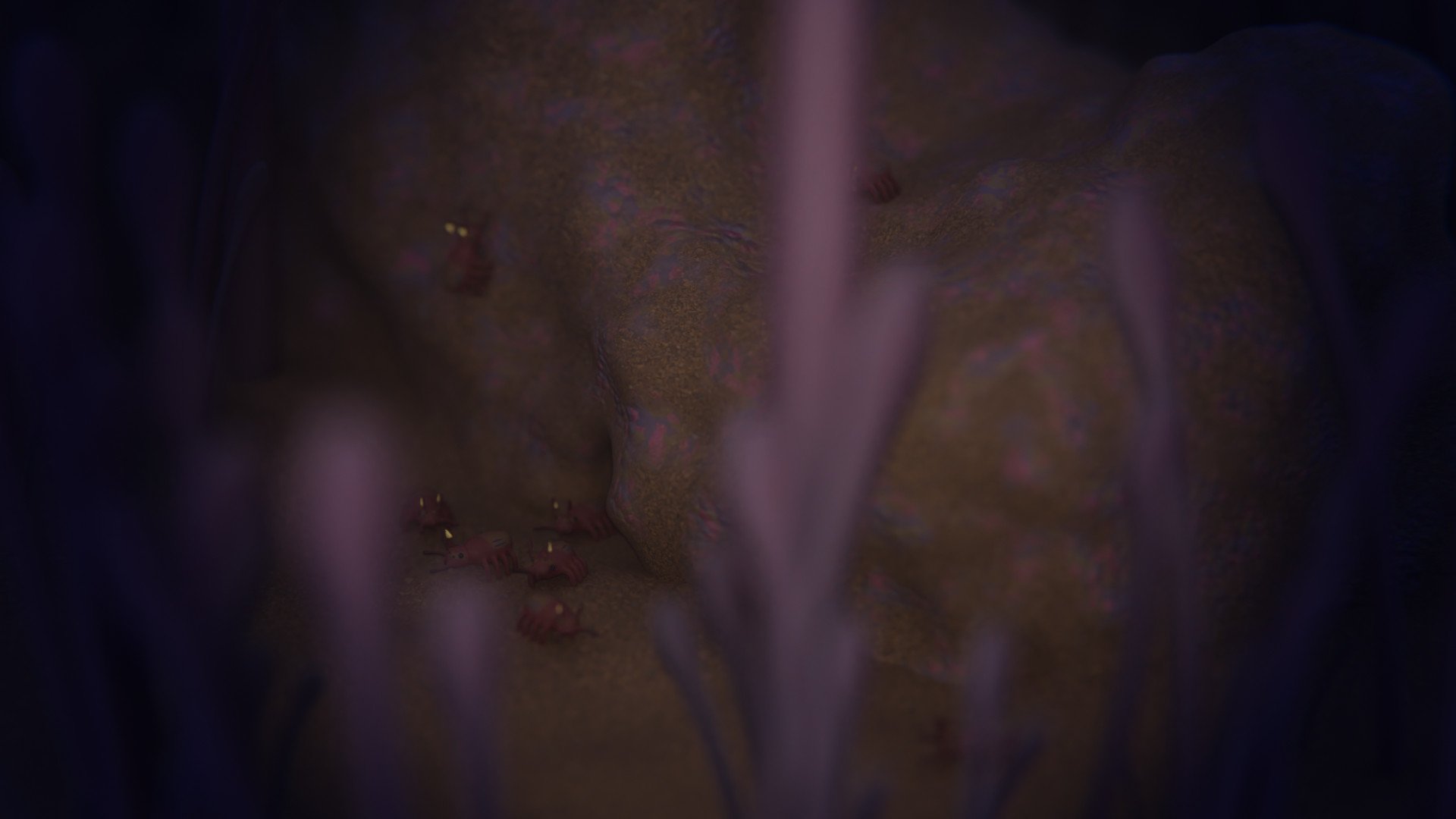Fortressmisa
In the wake of the mass extinction and the loss of the large predators the diminutive minospina’s were forced to adapt to deal with the influx of predators competing to fill in the niche of top predators. Some groups of minospina developed a taste for carrion as opposed to their original sugar based diet. This dietary change and the threat of new predators led to the evolution of a new species, the fortressmisa.
Fortressmisa’s were a nocturnal scavenger who lived in large eusocial colonies ruled over by a dominant fertile pair. Their name is derived from the fact they would construct large structures formed by the gluing together discarded shells and exoskeletons. These structures are made to look like the surrounding corals of their reef habitat.
Pictured here a group of fortressmisa are heading out of their nest for a foraging run. [creature design by Saurusblood]
Basic Information
Anatomy
The front appendages evolved to become more of a cutting appendage as well as a grasping one, lacking the spines of its ancestral appendages in favor of a more cutting edge. The antennae have grown larger and more triangular at the tips. The triangular growths are translucent and store the bioluminescent bacteria the fortressmisas used for communication. They activate the bioluminescent by shaking the antennae. The eyes have also grown to double the size of the ancestral Minospina. The tube-like mouth has become much longer and more needle-like. While not in use it folds to the ventral side of the head.
Internally though is where the majority of the changes have occurred. The fortressmisa’s stomach evolved into three separate chambers each positioned vertically above one another. The lower stomach is used for digestion and is connected to the anus. The secondary and largest stomach is used for storage and is referred to as the social stomach. The third is the smallest and is used to convert food into a sticky paste the the fortressmisa would use to help construct the hive.
Genetics and Reproduction
Fortressmisas used sexual reproduction but only royals are capable of reproduction. Male and female royals will leave their home hive the day after a storm and will begin their search for royals from other colonies. Once two have paired off they will search for an abandoned exoskeleton to repurpose as the beginning of their hive. The female will then lay her eggs and the male will fertilize them. This initial batch of workers will be fed off the royals energy reserves and the success of this first batch of workers will often determine the survival of the colony. For the first 80 to 90 days the royals will only be able to breed once per week, once the colony is fully established reproduction accelerates to once every 3 days.
Royals produce between 10-30 eggs each clutch depending on nutrition.
Growth Rate & Stages
A Fortressmisa emerged from its egg as a nymph, a miniature version of an adult depending on the amount of nutrition provided to the nymph it will grow into a reproductive royal or worker in 1 local week. Nymps are not born with bioluminescent bacteria and gain them through contact with adults.
Ecology and Habitats
Fortressmisas live exclusively in reef systems between Kub Shay and Yama as they can only disguise their colonies by imitating the corals.
Dietary Needs and Habits
Fortressmisas feed on carrion or organisms on the brink of death. They will inject their digestive juices into soft flesh, liquifying it for consumption. The fortressmisa will then either digest the material on site or divert it to its social stomach and return the food to the hive.
Additional Information
Social Structure
Fortressmisas are eusocial and cooperate to construct their hives and locate food sources. When two separate hives interact members of either hive will begin flashing their bioluminescence in an attempt to intimidate the other hive to leave the area. Violence between hives is non existent.
Average Intelligence
Fortressmisas display more complicated behavior with simple communication between members on the hive with the use of flashing bioluminescence on their antennae. Though it is limited to warning signals and follow signals. The construction of their hives is also evidence of some complicated behavior.
Perception and Sensory Capabilities
The fortressmisa’s eyes became larger and more sensitive to light.
Symbiotic and Parasitic organisms
Fortressmisas will often repurpose discarded exoskeletons from Armorglobes to help build their hives.
EXTINCT
Genetic Ancestor(s)
Scientific Name
Froúriomisa ypérythros
Origin/Ancestry
Paleotagmata
Lifespan
10 Local Years (For royals) 2 Local Months (For Workers)
Average Height
1.5 cm
Average Length
2 cm
Body Tint, Colouring and Marking
The red coloration of fortressmisas helps them remain hidden during the night.
Geographic Distribution
Remove these ads. Join the Worldbuilders Guild











Comments